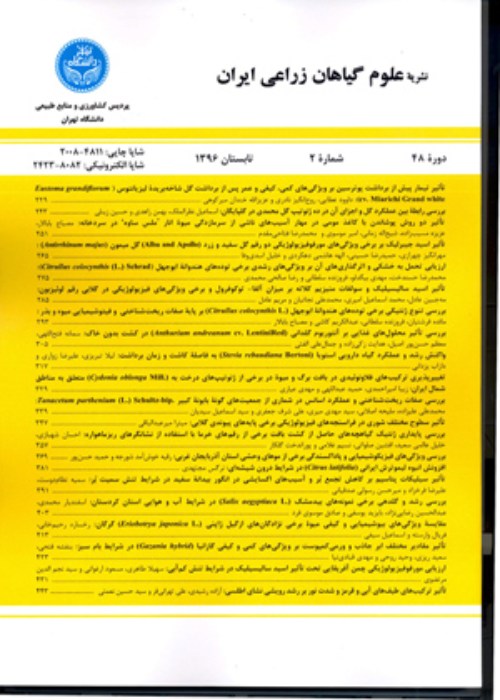Effects of Salt Stress on Seed Germination and Seedling Growth of some Iranian Rice (Oryza sativa L.) Genotypes and Cultivars
Abstract:
To study the physiological effects of different levels of salt stress on germination and on seedling stages, two seperate experiments were undertaken in Rice Research Institute of Iran, Amol in 2006. The experiments were conducted in a completely randomized design of three replications in greenhouse. Sixteen rice genotypes namely: Ahlamitarum, Shafagh, Gharib, Taromzavarak, Khazar, Mosatarom, Ghashange, PSBR-C88, Hybride- bahare –1, Nemat–A, Hassansaraie, Anbarboo, Gerde, Tichong and four salinity levels (O, 4, 8, 12 ds m-1) were tested. Characters assessed were percent and rate of germination, length and dry weight of rootlet and of stemlet, total dry weight, Na+ and K+ contents, K+/Na+ ratio, dry weight as well as length of roots and shoots, leaf area and total biomass. Results indicated that the effects of salinity, genotype as well as their interactions were highly significant on all the evaluated traits. In germination stage, in response to salinity effects all characters significantly differed with their correlation coefficients being positive and highly significant. Except in Na+ content and K+/Na+ ratio in roots and shoots, all the other assessed traits at the seedling stage showed reduction with increasing salinity trend and in a number of traits the correlation coefficients were positive and significant. Genotypes PSBR-C88 and Bahar-1 exhibited the highest and the lowest growth rates. They were determined as the respectively tolerant and susceptible genotypes to salinity for using in future further experiments. Finally, for a prediction of the relationships of total biomass and its components, and also exclusion of removal the less important variables for path analysis, stepwise regressions was employed. Results obtained from stepwise regression indicated that only two out of seven traits (rootlet and stemlet dryweight) at the germinating stage and merely two out of thirteen traits (root and shoot dryweight) at seedling stage contributed to total biomass production. However, results optained from path analysis indicated that only the variables of stemlet and shoot dry weight were very important. These traits directly and to a very large extent affect total biomass and thus can be employed in rice breeding programs. Also, path analysis revealed that a major portion of correlations of other traits (rootlet and root dryweight, in both germinating and seedling stages) with total biomass were related to their indirect effects via other variables.
Language:
Persian
Published:
Iranian Journal of Field Crop Science, Volume:40 Issue: 3, 2009
Page:
71
magiran.com/p743528
دانلود و مطالعه متن این مقاله با یکی از روشهای زیر امکان پذیر است:
اشتراک شخصی
با عضویت و پرداخت آنلاین حق اشتراک یکساله به مبلغ 1,390,000ريال میتوانید 70 عنوان مطلب دانلود کنید!
اشتراک سازمانی
به کتابخانه دانشگاه یا محل کار خود پیشنهاد کنید تا اشتراک سازمانی این پایگاه را برای دسترسی نامحدود همه کاربران به متن مطالب تهیه نمایند!
توجه!
- حق عضویت دریافتی صرف حمایت از نشریات عضو و نگهداری، تکمیل و توسعه مگیران میشود.
- پرداخت حق اشتراک و دانلود مقالات اجازه بازنشر آن در سایر رسانههای چاپی و دیجیتال را به کاربر نمیدهد.
In order to view content subscription is required
Personal subscription
Subscribe magiran.com for 70 € euros via PayPal and download 70 articles during a year.
Organization subscription
Please contact us to subscribe your university or library for unlimited access!



